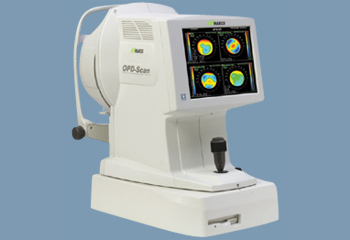
The Marco OPD Scan 3-D ARK 9000 provides information on corneal topography, wavefront, autorefraction, keratometry and pupillometry in one unit, utilizing state-of-the-art imaging and analysis technology developed specifically to measure normal to highly aberrated eyes.
The Marco OPD Scan 3-D ARK 9000 offers a variety of data maps to provide information on the total refractive error, wavefront, corneal shape, internal aberrations and visual quality of the eye, allowing highly accurate and reliable information for optic diagnostics.
Features:
• Many more data points than other aberrometers — allowing precise mapping of irregular astigmatism
• OPD Map shows point-by-point eye aberration
• Single-step measurement of corneal topography and refractive error data for reduced alignment errors
• Selectable measurement data for improved reliability
• Fully automated alignment of the XYZ axis
• Fast processing speed
• Improved accessibility to the eye
• Wide measurement range (Sphere -20.0D to +22.0D and Cylinder 0.0D to ±12.0D)
• High-resolution display (10.4 TFT-Color-LCD) with touch-screen operation
• Easy data maintenance with a detachable hard drive
• Marco OPD Scan 3-D is fully networkable
Topography Data:
• Eye Image – Allows the operator to see clarity of rings and to determine if registration is correct.
• Difference Maps – Monitor refractive changes in corneal power, or pathology by serial exams.
• Axial Map –Calculates the corneal curvature with respect to the optical axis and displays refractive power.
• Instantaneous Map (Tangential) – curvature displays the true shape of the cornea for pathology detection.
• Refractive Map – Displays the corneal refractive powers calculated by Snell’s Law, shows spherical aberration.
• 3-D Elevation Map – Shows the difference in elevation between a reference sphere and the corneal surface.
• 2-D Elevation Maps – Based on a reference sphere, gives values in microns and detects subtle changes.
Refraction Data:
• Zonal Refractive Maps – Refractive data, calculated in three zones. Includes global RMS indices.
Refraction and Keratometry Data:
• Refraction and Keratometry data – Automatically calculates and displays auto-refraction and keratometry data.












